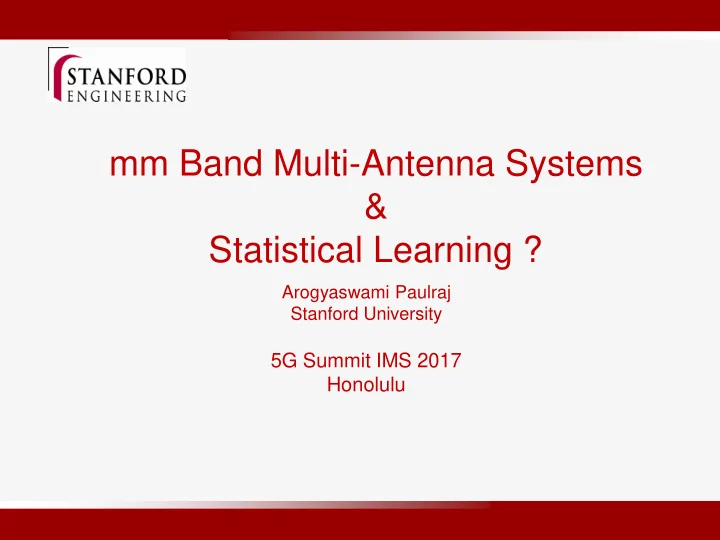

mm Band Multi-Antenna Systems & Statistical Learning ? Arogyaswami Paulraj Stanford University 5G Summit IMS 2017 Honolulu
Service Vision and Performance Low Power Massive Connectivity Low Latency Enhanced Broadband High Reliability Tele-Control, V2X High Speed
mm-Band in 5G RAN • Proposed US Bands - 28, 37, 39, 57 - 71 GHz • Propagation mode – LOS, near LOS, strong shadowing (Foliage and Rain loss, 60 Ghz small absorption loss) • Deployment – Small cells ~ 150m • Need large arrays – Antenna elements get smaller -> need to rebuild aperture to get reasonable ranges – either use reflectors / lenses or multiple antennas and beamforming
Large MIMO • Antennas – BS >> 32 – UE 2 - 8 • Narrow Base Station Beam widths – 6 to 2 deg • Channel BW 100 - 1500 MHz • Multiple Access - Beamforming essential – MU-MIMO – SU-MIMO + TDMA / FDMA
MIMO Modes • Single Stream (+TDMA) • Single User MIMO (+TDMA) • Multi User MIMO • Distributed Multi User MIMO
Knowledge and Predictability
Performance Optimization • Poor knowledge and predictability is a challenge – Handover – Channel Knowledge and Predication – Scheduling – Interference – More …. Opportunities for using statistical learning?
Channel State Information • MU-MIMO needs good Transmit Channel Information (not so for simple beamforming) – FDD (or Closed loop TDD) – Simple Pilot based techniques is overhead expensive – In TDD – Tx- Rx calibration is hardware expensive • Higher channel variability in vehicular environments
Handover • Strong shadowing means multiple base stations need to support a terminal with rapid handovers to select the best serving station • Managing handover (& neighbor list ) is complicated
Interference • Interference is much more dynamic than 4G due to narrow beams – depends on user position, base station beam pointing schedule (NAIC)
Scheduling • Scheduling gets more complicated because of tight inter-BS coupling • Backhaul (S1) bandwidth management also comes into play
Statistical Learning • CART, SVMs, DNN, CNN, RNN, RL,…. • Can be useful in applications where there is too little state knowledge or predictability for convex/nonconvex programming, instead works by learning patterns and relationships to extract self programming • But very fragile… still in Infancy
Handwriting Recognition
Channel Estimation Given Location Learning the correspondence mapping between Tx and Rx manifolds can help Channel Estimation
Credit Risk
User Likely to Download Movie ?
Summary New frontier but many open issues! Rasa Networks …
Recommend
More recommend